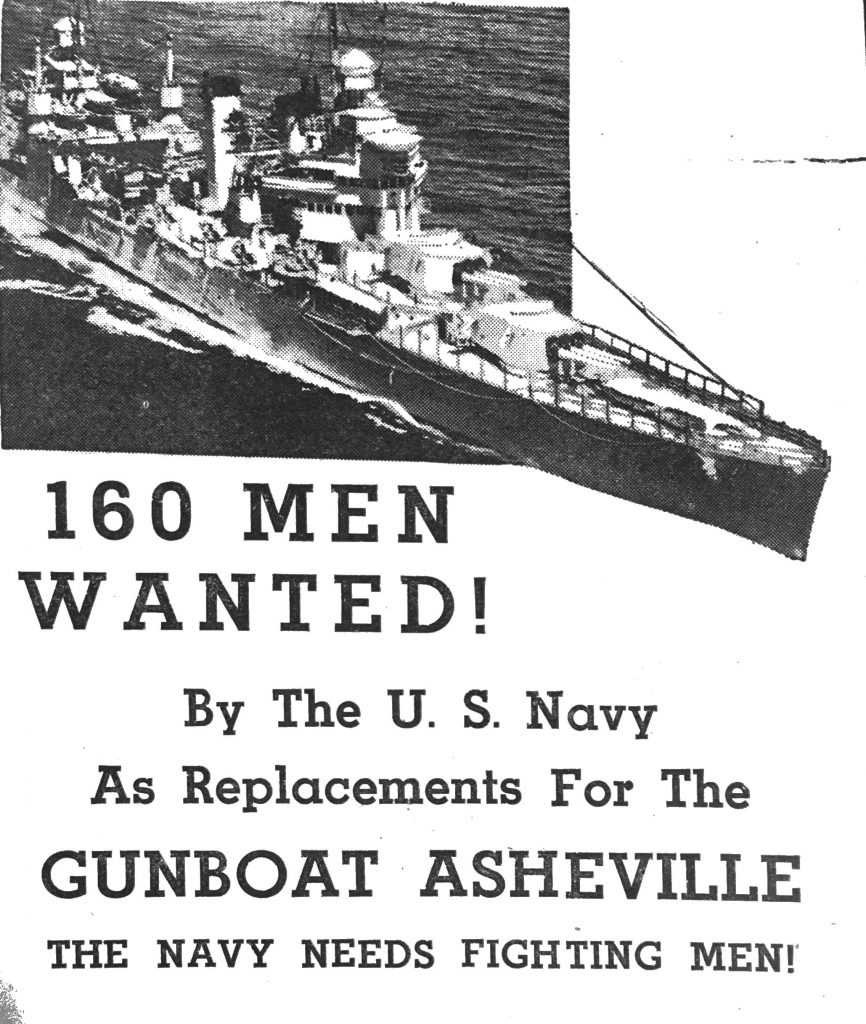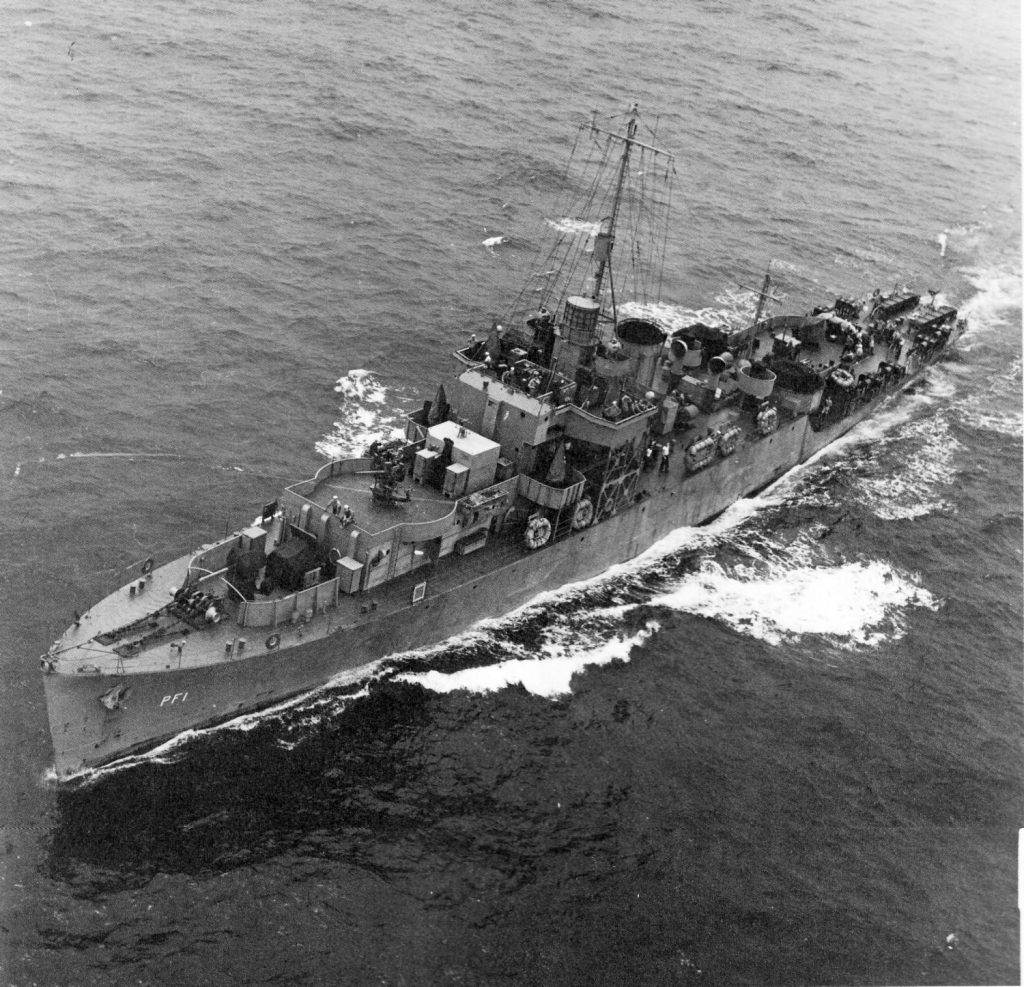
The Second U.S.S. Asheville ship was a patrol frigate that was launched in August of 1942.2 Built in Montreal, Canada, it was commissioned on December 1, 1942, as an escort vessel in World War II.3 Originally a part of a Lend-Lease program and named HMS ADUR, it was taken over by the United States and renamed the U.S.S. Asheville, PF-1.4 The HMS ADUR was originally commissioned by the British Royal Navy, but was transferred to the United States before its completion.5 In the beginning of her career, she escorted convoys between Guantanamo Bay, Cuba, and New York.6
These escorts played a crucial role in the midst of World War II. Convoy is defined as ” one or more merchant ships or naval auxiliaries sailing under the protection of one or more warships.” 7 While the Asheville escorted merchant ships back and forth from Guantanamo Bay, Cuba to New York, the United States, England, and Canada had allied convoy escorts going all across the world. The merchant ships would carry anything from oil, lumber, steel, paper, and many other goods. These escorts would help transport anywhere from 2 to 20 merchant ships at a time.
A career change was in order for the PF-1 the winter of 1943 and 1944. The PF-1 patrolled the waters off of Cape Hatteras. 8 Here, the ships main purpose was to patrol the waters for German submarines. More popularly known as U-boats, Germany sent out 1,150 subs between 1935 and 1942.9 Armed with torpedoes, these U-boats attacked independent shipping and merchant ships that had already been shot by German aircraft.10 The Outer Banks were of interest in WWII after 1942, when U-boats attacked a U.S. freighter.11 Nicknamed “Torpedo Junction,” the waters off of Cape Hatteras were swimming with German U-boats aiming to sink allied ships carrying supplies.12

Following this winter, the Asheville was refitted with anti-submarine warfare gear in Boston, Massachusetts and had another career change. She then participated in antisubmarine warfare experiments in Port Everglades, Florida, and Quonset Point, Rhode Island. 14
The Asheville changed her career again to serve as an experimental radar ship.15 This part of her career lasted from September of 1945 until her decommissioning in January of 1946. 16
Specifications17
- Displacement: 1,335 tons
- Length: 301’6″
- Beam: 36’6″
- Draft: 13’8″
- Speed: 20 knots
- Guns: 3″
- Crew: 194 people
- Asheville Citizen Times, Box M1999.02.03, Walter Ashe Collection, D.H. Ramsey Library Special Collections, University of North Carolina, Asheville, NC.
- Walter Ashe, U.S.S. Asheville Narrative, Box M1999.02.01, Folder M99.2.1.3.7, Walter Ashe Collection, D.H. Ramsey Library Special Collections, University of North Carolina at Asheville, Asheville, NC.
- Ron Holland and Walter Ashe, “U.S.S. Asheville,” Box M1999.02.01, Folder M99.2.1.1, Walter Ashe Collection, D.H. Ramsey Library Special Collections, University of North Carolina at Asheville, Asheville, NC.
- Ron Holland and Walter Ashe, “U.S.S. Asheville,” Box M1999.02.01, Folder M99.2.1.1, Walter Ashe Collection, D.H. Ramsey Library Special Collections, University of North Carolina at Asheville, Asheville, NC.
- “HMS Adur (K 269),” uboat.net, accessed March 20, 2019, https://uboat.net/allies/warships/ship/7888.html
- Ron Holland and Walter Ashe, “U.S.S. Asheville,” Box M1999.02.01, Folder M99.2.1.1, Walter Ashe Collection, D.H. Ramsey Library Special Collections, University of North Carolina at Asheville, Asheville, NC.
- Arnold Hague, The Allied Convoy System (Annapolis, MD: Naval Institute Press, 2000), 16.
- Ron Holland and Walter Ashe, “U.S.S. Asheville,” Box M1999.02.01, Folder M99.2.1.1, Walter Ashe Collection, D.H. Ramsey Library Special Collections, University of North Carolina at Asheville, Asheville, NC.
- Hague, 48.
- Hague, 49.
- Kevin P. Duffus, “U-Boats off the Outer Banks: When World War II Was Fought off North Carolina’s Beaches,” accessed March 20, 2019, https://www.ncpedia.org/history/20th-Century/wwii-uboats.
- Duffus.
- “U.S.S. Asheville (PF-1)”, Navsource.org, Accessed April 1, 2019, http://www.navsource.org/archives/12/08001.htm
- Ron Holland and Walter Ashe, “U.S.S. Asheville,” Box M1999.02.01, Folder M99.2.1.1, Walter Ashe Collection, D.H. Ramsey Library Special Collections, University of North Carolina at Asheville, Asheville, NC.
- Ron Holland and Walter Ashe, “U.S.S. Asheville,” Box M1999.02.01, Folder M99.2.1.1, Walter Ashe Collection, D.H. Ramsey Library Special Collections, University of North Carolina at Asheville, Asheville, NC.
- “USS Asheville II,” Box M1999.02.01, Folder M99.2.1.1, Walter Ashe Collection, D.H. Ramsey Library Special Collections, University of North Carolina at Asheville, Asheville, NC.
- Ron Holland and Walter Ashe, “U.S.S. Asheville“, Box M1999.02.01, Folder M99.2.1.1, Walter Ashe Collection, D.H. Ramsey Library Special Collections, University of North Carolina at Asheville, Asheville, NC.